Topics
- Article
- Member Stories
- Training & Exercise
The Record-Setting Triple 7 Expedition: Pushing the Limits of Human Performance
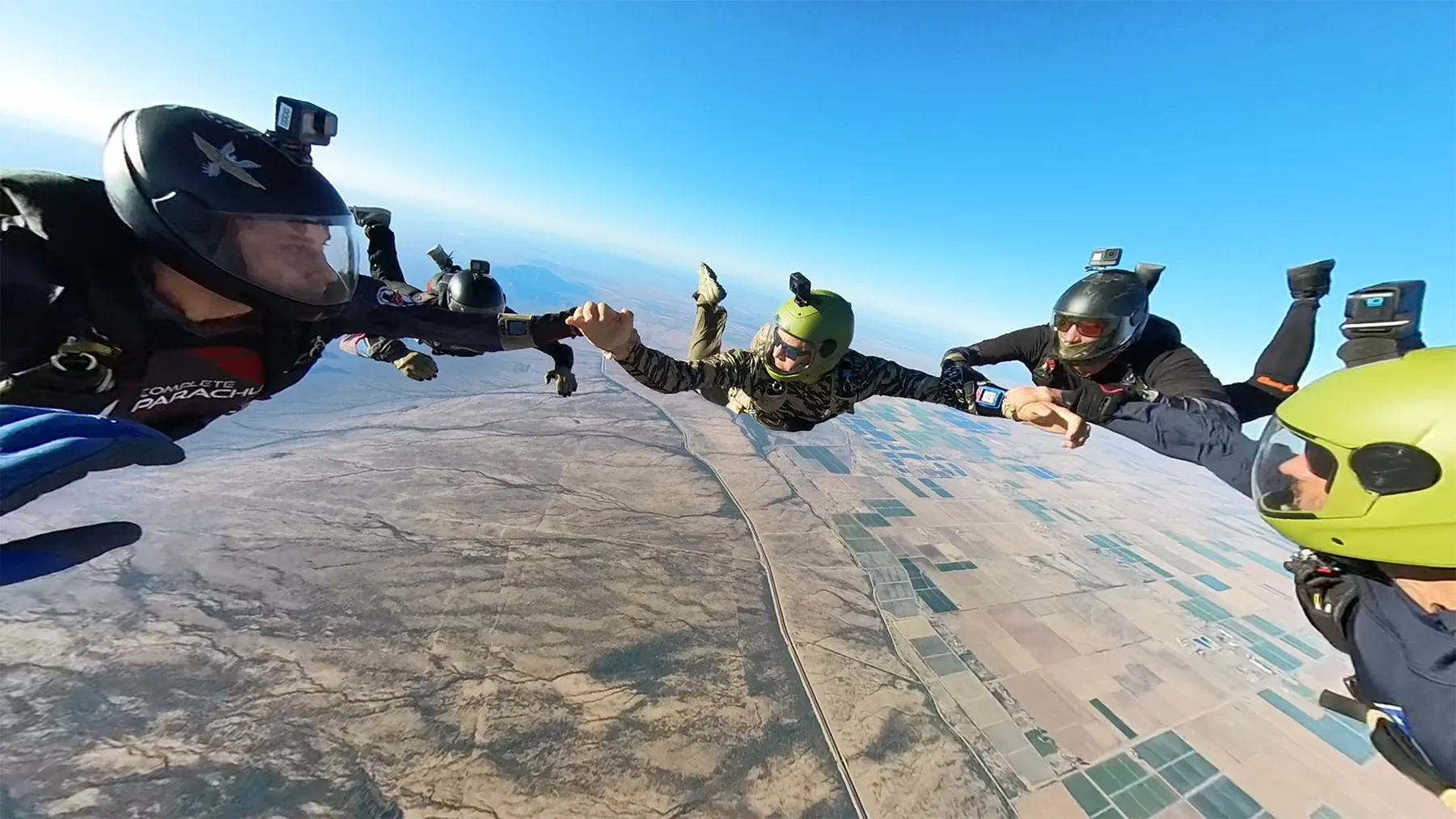
7 skydives. 7 continents. 7 days. Undertaking a record-breaking skydiving attempt comes with challenges – we take a look behind the data.
UNDERTAKING THE TRIPLE 7 EXPEDITION
On January 9, 2023, 9 Former US and Canadian service members undertook an ambitious mission – to complete 7 skydives on 7 continents in 7 days. With plans to stop in Antartica, Chile, Miami, Barcelona, Cairo, Abu Dhabi, and Australia one thing was abundantly clear – the journey to complete this record-breaking attempt began long before January. The team of veterans knew that the demands this would place on their bodies would be immense, from the physicality of the jumps, to the impact on sleep traveling through various time zones. They assembled a team of performance experts, including the team at WHOOP, to truly understand the demands they would be putting on their bodies. We took a look at the WHOOP data of the expedition team to break down exactly what a mission like this demanded – and how that compared to the general WHOOP population.
HOW THE EXPEDITION TEAM COMPARED TO AN-AGED AND GENDER MATCHED GROUP
Each member of the expedition team wore WHOOP for 24/7 monitoring of both the training and the expedition. Compared to other 48-year old male users, the team of ex-special operations forces was fitter and healthier. Heart rate variability, one of the best objective metrics for physical fitness and determining your body’s readiness to perform, was higher than the age-matched cohort, and their resting heart rate, a metric to monitor your fitness level and overall health, was lower – good signs of health.
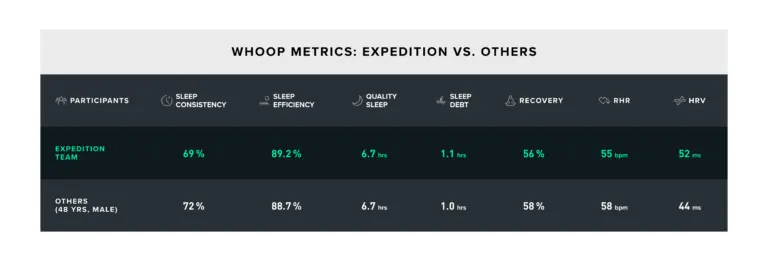
HOW TRAVEL AFFECTED SLEEP
The data shows that the expedition, including flights and travel time, took a toll on the team’s bodies, making sleeping and maintaining a circadian rhythm challenging. Unsurprisingly, the team’s sleep suffered throughout the expedition, with the team averaging 4.25 hours of quality sleep during the expedition compared to their baseline of 7 hours. Overall, they logged less light sleep, slow wave sleep, and REM sleep, which are necessary for the body to rebuild, grow, and restore.
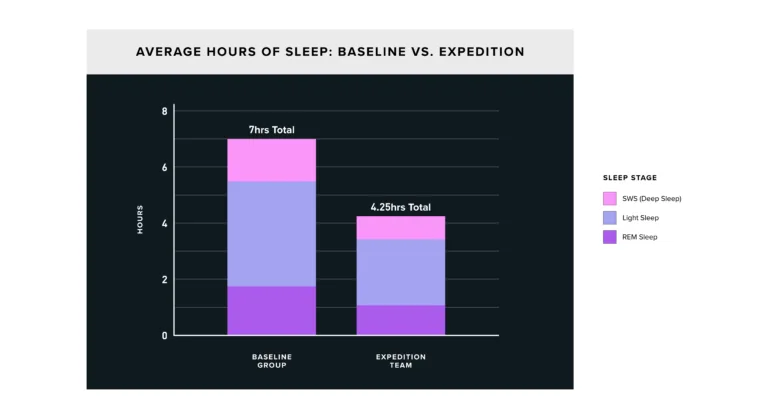
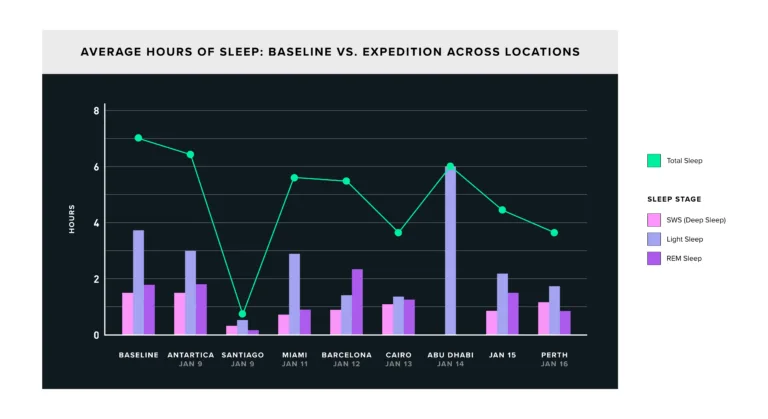
BALANCING THE DEMANDS OF THE EXPEDITION WITH RECOVERY
WHOOP quantifies the amount of physical and mental stress you’re putting on your body, using heart rate to calculate an overall strain score. This means that Strain doesn’t just track hard workouts or activities, but any emotionally stressful situations that drive your heart rate up. The recovery score, another proprietary metric of WHOOP, tells you how prepared your body is to take on strain.
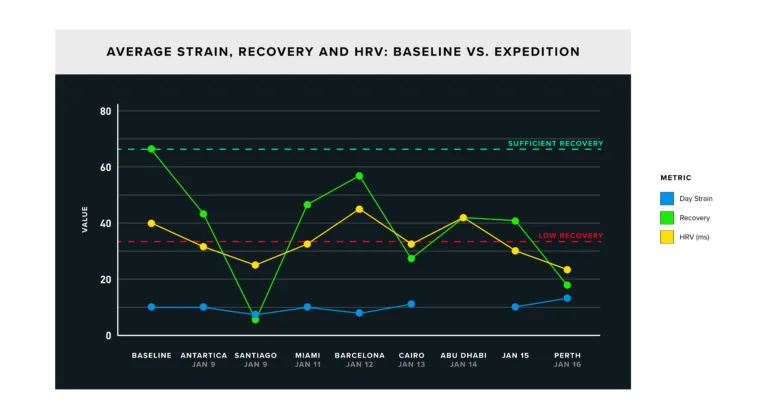
During the expedition, the team was never in the green – a sign that they were pushing their physical limits. Additionally, stress can drive up Strain, and logistical expedition challenges could have contributed to the fatigue the team felt. In Cairo, despite low recovery, the team’s strain was higher than baseline which led to higher HRV indicating fitness gains the following day. In Chile, on the other hand, the team experienced their lowest recovery, but also had their lowest strain (8). Taking this day easy led them to bounce back to the yellow recovery zone the next day. A long flight to Perth meant the crew did not get enough sleep, leading to a low recovery on the day of their last jump.
HOW HEART RATE CHANGED WHILE SKYDIVING

The average day heart rate of the team was 72.06. During the jumps on all 7 continents, the team’s heart rates exceeded baseline. Extreme activities like skydiving can increase adrenaline, driving heart rate up, as can external factors. The team’s heart rates reflect the unique conditions and challenges of the jump location. The Triple 7 exhibition team described Antarctica and Cairo as having unique and beautiful views. On the other hand, Barcelona had low visibility, and Perth’s 20+ mph winds may have made maneuvering in the air difficult, bringing up their heart rate.
THE RECORD: BROKEN
The Triple 7 Expedition was a monumental undertaking – and the WHOOP data confirms that it was pushing the limits of the human body. The team never received sufficient rest or recovery, leading to physical exhaustion. Despite the physiological demands and the logistical challenges of the expedition, the team completed in 6 days, 6 hours and 6 minutes, breaking three world records. Through the expedition, the team of veterans raised money to fund “Folds of Honor”, providing scholarships to military families.